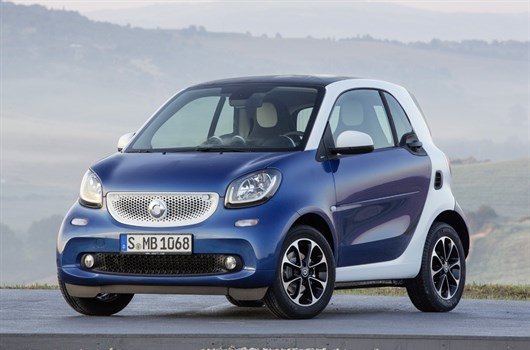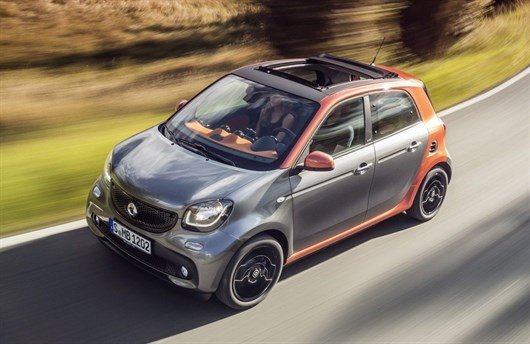Smart unveils new ForTwo and ForFour

Smart has revealed the all-new ForTwo – as well as a radical new ForFour, which adds two additional seats and doors but keeps the engine at the back. Both are set to go on sale in November with expected prices of around £10,000 for the ForTwo with the ForFour costing a further £500.
The original ForTwo’s appeal lay in its combination of funky design, Mercedes-Benz parentage and a Porsche 911-mimicking rear-engine configuration. That remains the case, but in response to the relative unpopularity of the more conventional, front-engined original ForFour, this time around the four-seat Smart has changed.
As before, compactness is the defining feature of the ForTwo, which comes in at just 2.69 metres long, while the five-door ForFour measures in at 3.49 metres, making it fractionally shorter than a Volkswagen Up. Both cars are designed with the evolutionary spirit you’d expect, retaining the quirky minimalism of their predecessors, while improving quality, safety, space and efficiency.
Lower and wider by 10mm and 100mm respectively, the ForTwo boasts a 260-litre boot – up from 230 litres in the last car – while in yet another move away from the traditional positioning of its predecessor, the ForFour’s boot is actually smaller, at 185 litres.
That said, the ForFour’s rear seats can be folded down to unleash a positively roadie-friendly 975-litre space. Both cars have a tailgate that splits horizontally, with top and bottom hinges.
Developed in conjunction with Renault alongside the new Twingo, the Smart pair get power from a choice of two petrol engines, both three-cylinder units: a 1.0-litre with 71PS or a 0.9-litre turbo with 90PS. Power is fed to the wheels via either a five-speed manual or a twin-clutch automatic transmission. No fuel economy or emissions numbers yet, but we wouldn’t expect Smart owners to be troubled for any VED payments.
A close look at the cabin shows that while the design may have a more premium feel, including a colour touchscreen multimedia interface, there are some noticeable Renault parts.
As before, the safety of Smart occupants is handled by a system Smart calls the tridion cell, which is further developed with a specific focus on crash compatibility with larger, heavier cars. It uses “a high proportion of ultra-high strength hot-formed steels and maximum-strength multiphase steel,” says Smart, adding that both cars performed well in frontal collisions with the Mercedes-Benz S-Class and C-Class.
In addition, the Smart pair are available with options like front collision warning and Lane Keeping Assist – safety features that were until very recently reserved for much more expensive cars.
Smart says that both cars have been “configured for gently understeering handling characteristics,” and to that end both have narrower front tyres than rear. The ForTwo also boasts an exceptionally small turning circle: 6.95 metres, which is considerably tighter than the famously miniscule 7.6-metre turning circle of a London cab. It’s the smallest of any production car.


.jpg)
.jpg)
.jpg)
.jpg)
 Mark Nichol
Mark Nichol
 Honest John Awards 2017: Land Rover Discovery Sport named Most Popular SUV for second year in a row
Honest John Awards 2017: Land Rover Discovery Sport named Most Popular SUV for second year in a row
 2022 Smart #1 SUV: price, specs and release date
2022 Smart #1 SUV: price, specs and release date
 2023 Ferrari Purosangue SUV: Prices, specs and release date
2023 Ferrari Purosangue SUV: Prices, specs and release date
 Citroen DS3 Racing revealed
Citroen DS3 Racing revealed
 Infiniti adds diesel to the range
Infiniti adds diesel to the range
 Volvo XC90 chosen as SUV of the year at 2014 Honest John Awards
Volvo XC90 chosen as SUV of the year at 2014 Honest John Awards
 March new car registrations better than expected
March new car registrations better than expected





.jpg)






Add a comment